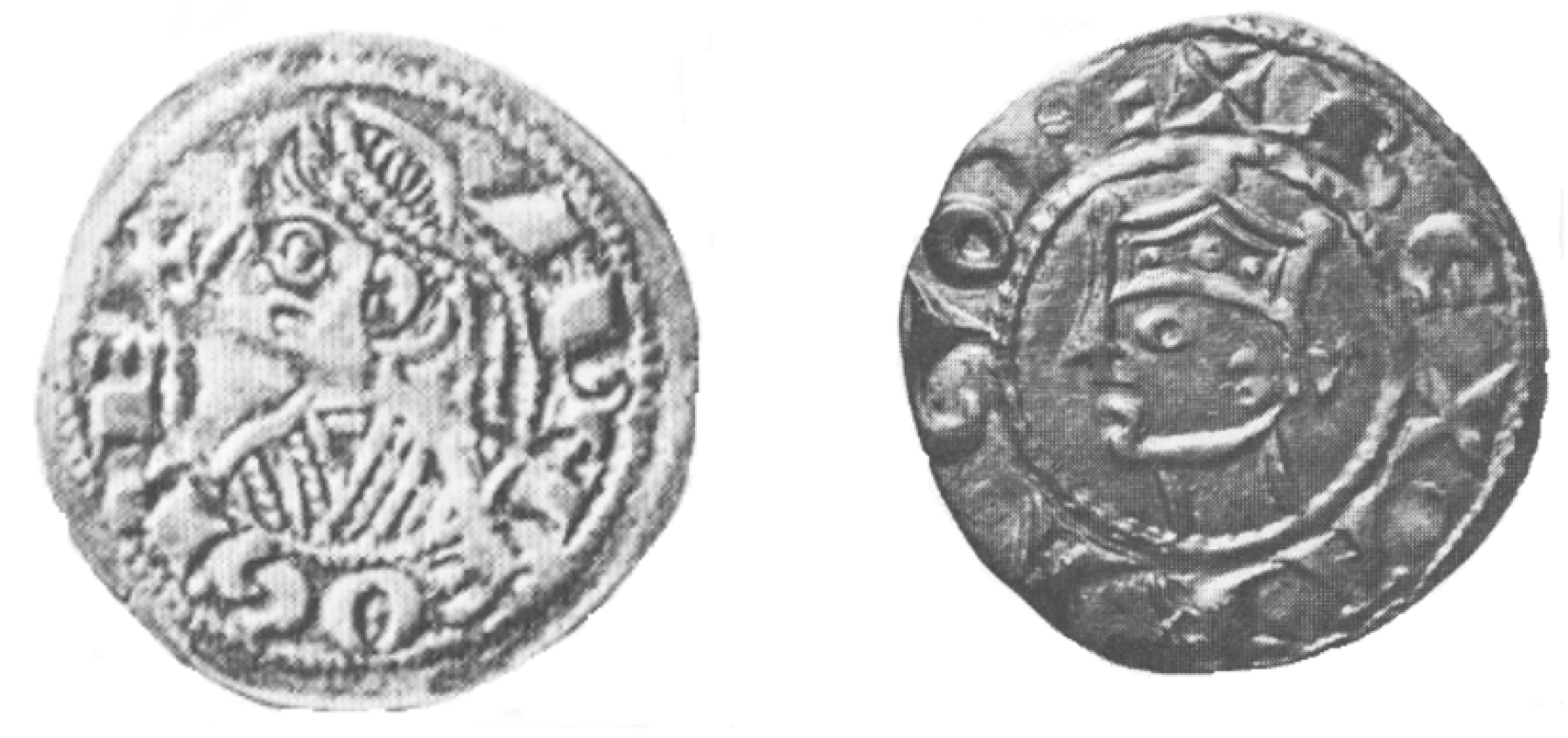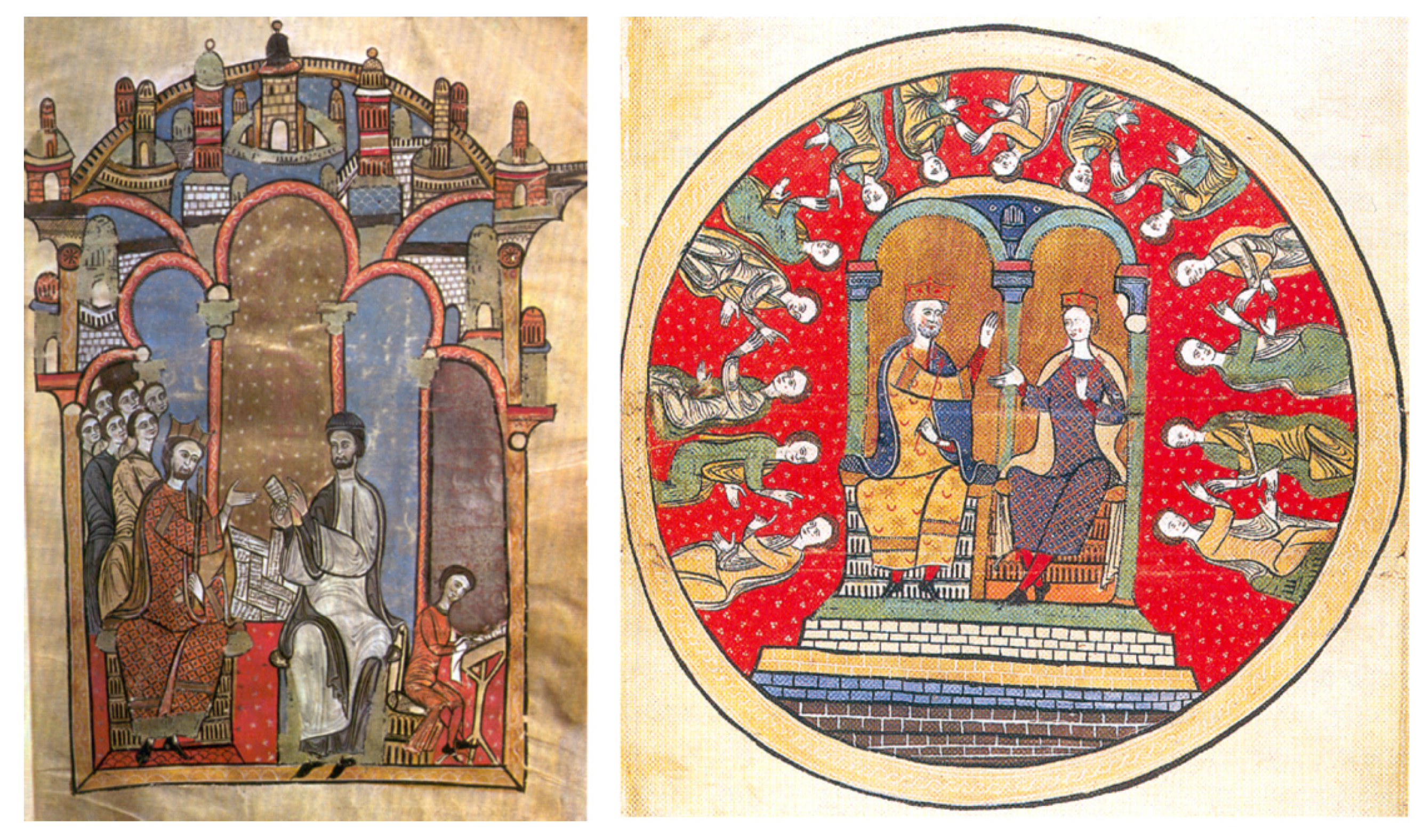Alphonse II of Aragon (1164–1196)
Definition
:1. The Creation of the So-Called Crown of Aragon
2. Appearance and Cultural Interests
3. Iconography on Coins and Seals
3.1. Coins: Survival and Innovation
3.2. New Pendant Seal with Dual Entitlement
4. Iconography in Legal Documents
4.1. Alphonse II’s Confirmation of Privileges
4.2. Liber Feudorum Maior
4.2.1. The Illustrations of the Early Master
4.2.2. The Illustrations of the Later Master
4.3. Liber Feudorum Ceritaniae
5. Images after His Reign
6. Conclusions
Funding
Conflicts of Interest
Entry Link on the Encyclopedia Platform
References
- Caruana, J. Itinerario de Alfonso II de Aragón. Estudios de Edad Media de la Corona de Aragón 1961, 7, 73–298. [Google Scholar]
- Lacarra, J.M. Alfonso II el Casto, rey de Aragón y Conde de Barcelona. In VII Congreso de Historia de la Corona de Aragón; Universitat de Barcelona: Barcelona, Spain, 1962; Volume I, pp. 95–120. [Google Scholar]
- Garballo, A.J. Alfonso II. In Los Reyes de Aragón; Centellas, R., Ed.; Caja de Ahorros de la Inmaculada: Zaragoza, Spain, 1993; pp. 67–72. [Google Scholar]
- Sánchez, A.I. Alfonso II Rey de Aragón, Conde de Barcelona y Marqués de Provenza. Documentos (1162–1196); Institución Fernando el Católico: Zaragoza, Spain, 1995. [Google Scholar]
- Ruiz, J.E. A propósito de Alfonso, rey de Aragón, conde de Barcelona y marqués de Provenza; Real Academia de Buenas Letras: Barcelona, Spain, 1996. [Google Scholar]
- Jenkins, E. The Mediterranean world of Alfonso II and Peter II of Aragon (1162–1213); AIAA: New York, NY, USA, 2012. [Google Scholar]
- Riquer, M. La poesia d’Alfons, dit el Cast. In VII Congreso de Historia de la Corona de Aragón; Institución Fernando el Católico: Zaragoza, Spain, 1963–1964; pp. 123–140. [Google Scholar]
- Engel, A.; Serrure, R. Traité de Numismatique du Moyen Age, 2nd ed.; Arnaldo Forni: Paris, France, 1890; Volume 2, p. 177. [Google Scholar]
- Mateu, F. Les relacions del Principat de Catalunya i els Regnes de València i Mallorca amb Anglaterra i el paral·lelisme monetari d’aquests països durant els segles XIII, XIV i XV; Societat Castellonenca de Cultura: Castelló, Spain, 1934; pp. 14, 51. [Google Scholar]
- Gil, O. Estudio crítico de las primitivas acuñaciones navarras y aragonesas. Numisma 1955, 31–96, 42. [Google Scholar]
- Serrano, M. Effigies Regis Aragonum. La imagen figurativa del rey de Aragón en la Edad Media; Institución Fernando el Católico: Zaragoza, Spain, 2015; p. 30. [Google Scholar]
- De Sagarra, F. Sigil·lografia catalana. Inventari, descripció i estudi dels segells de Catalunya; Estampa d’Henrich: Barcelona, Spain, 1916–1932; Volume I, num. 7; p. 201. [Google Scholar]
- Bautier, R.H. Échanges d’influences dans les chancelleries souveraines du Moyen Age d’après les types des sceaux de Majesté. In Chartes, sceaux et chancelleries. Études de diplomatique et de sigillographie médiévale; Droz: Paris, France, 1990; pp. 192–220, 575. [Google Scholar]
- Conde, R. Sello de plomo de Jaime I. In Cataluña Medieval; Lunwerg: Barcelona, Spain, 1992; p. 114. [Google Scholar]
- Durán, A. Colección diplomática de la catedral de Huesca; Instituto de Estudios Pirenaicos: Zaragoza, Spain, 1965; Volume 1, p. 299. [Google Scholar]
- Grabar, A. La iconoclastia bizantina. Dossier arqueológico; Akal: Madrid, Spain, 1998 (1994); p. 68. [Google Scholar]
- Serrano, M. La imagen como instrumento: El rey al servicio del códice, el códice al servicio del rey. In Libros con arte, arte con libros; Universidad de Extremadura: Cáceres, Spain, 2007; pp. 659–667. [Google Scholar]
- Mundó, M. El pacte de Cazorla del 1197 i el Liber Feudorum Maior. Notes paleogràfiques i diplomàtiques. In X Congreso de Historia de la Corona de Aragón; Institución Fernando el Católico: Zaragoza, Spain, 1980; pp. 123–126. [Google Scholar]
- Ibarburu, M.E. Los cartularios reales del Archivo de la Corona de Aragón. Lambard 1994, 6, 198. [Google Scholar]
- Ibarburu, M.E. De capitibus litterarum et aliis figuris; Universitat de Barcelona: Barcelona, Spain, 1999; p. 348. [Google Scholar]
- Kosto, A.J. The Liber Feudorum Maior of the counts of Barcelona: The cartulary as an expression of power. J. Mediev. Hist. 2001, 27, 2. [Google Scholar] [CrossRef]
- Wearing, S. The death of the patron: Agency, style and the making of the Liber Feudorum Maior of Barcelona. In Romanesque Patrons and Processes; Camps, J., Castiñeiras, M., McNeill, J., Plant, R., Eds.; Routledge: London, UK, 2018; pp. 327–336. [Google Scholar]
- Bohigas, P. La ilustración y la decoración del libro manuscrito en Cataluña. Contribución al estudio de la miniatura catalana; Asociación de Bibliófilos: Barcelona, Spain, 1960; pp. 102–103. [Google Scholar]
- Garnier, F. Le langage de l’image au Moyen Age. Signification et symbolique, 2nd ed.; Léopard d’Or: Paris, France, 1982; p. 174. [Google Scholar]
- Martínez, J.E. Baixa Edat Mitjana. S. XII.-XV. In Història dels Catalans, 2nd ed.; Soldevila, F., Ed.; Ariel: Barcelona, Spain, 1970; p. 1006. [Google Scholar]
- Alcoy, R. Ilustrador de la Pasión o Maestro de la Pasión. Viga de la Pasión. In Prefiguración del Museu Nacional d’Art de Catalunya; Barral, X., Ed.; Museu Nacional d’Art de Catalunya and Lunwerg: Barcelona, Spain, 1992; pp. 168–171. [Google Scholar]
- Yarza, J. Arte y Arquitectura en España. 500–1250, 7th ed.; Cátedra: Madrid, Spain, 1994; p. 307. [Google Scholar]
- Martínez, J.E. Hallazgo de miniaturas románicas en el Archivo de la Corona de Aragón; Asociación de Bibliófilos: Barcelona, Spain, 1944; p. 5. [Google Scholar]
- Fernández Pozzo, S. The king’s dashing attire at the turn of the thirteenth century. Alfonso II and Pedro II of the Crown of Aragón in the Liber Feudorum Maior and Liber Feudorum Ceritaniae. In The Ruler’s Image and Its Multiple Functions in the Medieval Mediterranean; Bacci., M., Studer-Karlen, M., Vagnoni, M., Eds.; in press.
- Kauffmann, C.M. Romanesque manuscripts. 1066–1190. A survey of manuscripts illuminated in the British Isles; Harvey Miller: London, England, 1975; num. 34, figs. 79–83 and 90. [Google Scholar]
- Coll, G. Els Usatges de la catedral de Lleida: Un manuscrit il·luminat autòcton de la pròpia Seu datat entre 1333 i 1336. In La Seu Vella de Lleida. La catedral, els promotors, els artistes, s. XII a s. XV; Generalitat de Catalunya: Barcelona, Spain, 1991; pp. 147–152. [Google Scholar]
- Alcoy, R. La il·lustració de manuscrits a Catalunya. In Ars Cataloniae, Art de Catalunya; Barral, X., Ed.; L’Isard: Barcelona, Spain, 2000; Volume I, p. 72. [Google Scholar]
- Coll, G. Manuscrits jurídics i il·luminació. Estudi d’alguns còdex dels usatges i constitucions de Catalunya i del decret de Gracià; Abadia de Montserrat: Barcelona, Spain, 1995; p. 225. [Google Scholar]
- Riera, S. Les fonts municipals del període 1249–1714. Guia d’investigació. Quaderns d’Història 2000, 4, 239–271. [Google Scholar]
- Alcoy, R. La introducció i derivacions de l’italianisme a la pintura gòtica catalana. 1325–1350 (PhD); Universitat de Barcelona: Barcelona, Spain, 1988; pp. 552–553. [Google Scholar]
- Escandell, I. Llibre Verd. In Cataluña medieval; Lunwerg: Barcelona, Spain, 1992; p. 304. [Google Scholar]
- Coll, G. El “Decretum Gratiani” de la British Library. Lambard 1991–1993, 278–290, 284. [Google Scholar]
- Yarza, J. La il·lustració. In El Primer volum del Llibre Verd de Barcelona; Base: Barcelona, Spain, 2005; pp. 141–156. [Google Scholar]
- Llibre de Privilegis de Cervera. 1182–1456; Turull, M. (Ed.) Noguera: Barcelona, Spain, 1991. [Google Scholar]
- Planas, J. El esplendor del gótico catalán. La miniatura a comienzos del siglo XV; Universitat de Lleida: Lleida, Spain, 1998; p. 192. [Google Scholar]
- Gimeno, F.; Serra, A. Representar la dinastía: El manuscrito genealógico del monasterio de Poblet. In Genealogia dels Comtes de Barcelona i Reis d’Aragó; Patrimonio: Valencia, Spain, 1997. [Google Scholar]
- Marés, F. Las tumbas reales de los monarcas de Cataluña y Aragón del monasterio de Santa María de Poblet; Asociación de Bibliófilos: Barcelona, Spain, 1952; doc. 35; pp. 183–185. [Google Scholar]






Publisher’s Note: MDPI stays neutral with regard to jurisdictional claims in published maps and institutional affiliations. |
© 2021 by the author. Licensee MDPI, Basel, Switzerland. This article is an open access article distributed under the terms and conditions of the Creative Commons Attribution (CC BY) license (https://creativecommons.org/licenses/by/4.0/).
Share and Cite
Serrano-Coll, M. Alphonse II of Aragon (1164–1196). Encyclopedia 2021, 1, 1166-1174. https://doi.org/10.3390/encyclopedia1040087
Serrano-Coll M. Alphonse II of Aragon (1164–1196). Encyclopedia. 2021; 1(4):1166-1174. https://doi.org/10.3390/encyclopedia1040087
Chicago/Turabian StyleSerrano-Coll, Marta. 2021. "Alphonse II of Aragon (1164–1196)" Encyclopedia 1, no. 4: 1166-1174. https://doi.org/10.3390/encyclopedia1040087
APA StyleSerrano-Coll, M. (2021). Alphonse II of Aragon (1164–1196). Encyclopedia, 1(4), 1166-1174. https://doi.org/10.3390/encyclopedia1040087





